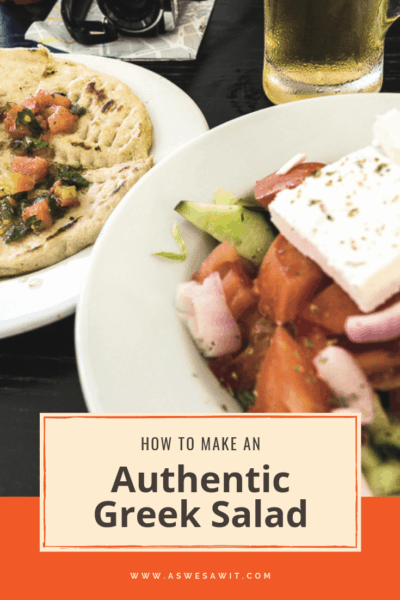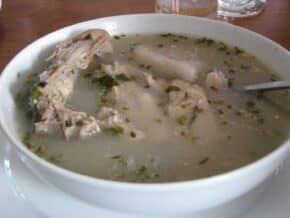While we were in Greece, both Dan and I ordered the same thing for lunch every day: a big, fat Greek salad. The natural blend of healthy ingredients was so simple and so refreshing that we just couldn’t get enough of it.
I don't know if Greek salad is the national dish, but I do know one thing: This salad is known and served in every corner of Greece. You'll even find it served in the best restaurants in Athens.

The rest of the world may call it a “Greek salad,” but the Greeks call it horiatiki salata, which means “village salad.” Rather fitting, I think, because practically everyone, even in the countryside, knows how to make it.
This article is going to tell you more about the authentic Greek salad, recipe and all.
What's in authentic Greek salad?

Does Greek salad contain lettuce? In a word, no. Please God, no.
Among Greeks there's a strict, unspoken rule about what is allowed to go into it. Whether in Corfu, Katakolon, Nafplio, or Athens, a traditional Greek salad recipe always (and only) includes:
- chunks of juicy tomatoes,
- slices of crunchy cucumbers,
- strips of green peppers,
- thin slivers of spicy red onions,
- plump Kalamata olives, and
- a massive slab of sheep’s milk feta cheese
Finally, the salad is sprinkled with oregano, and brought to your table glistening with fragrant, emerald olive oil.
That’s it. If you add anything else to the mix, they claim, it won’t be a real Greek salad.
Okay, maybe so, but certain regions of Greece like to serve it with a splash of red wine vinegar (I’m looking at you, Thessaloniki and Crete). And that’s all I’m saying; you can eat it however you wish.
ⓘ TIP: If you're at a Greek restaurant and want an authentic, traditional Greek salad (with no lettuce), tell your waiter you would like a horiatiki, rustic, or village salad instead of a “Greek salad.” If it's a bona fide Greek restaurant, he'll know what you're asking for.
Traditional Greek Salad (Horiatiki Salata)
Equipment
- large mixing bowl
Ingredients
- 3 medium tomatoes cut in wedges
- 1 small red onion sliced into thin rings
- 1 seedless cucumber sliced into half moons
- 1 green pepper sliced into strips
- 8 oz kalamata olives
- 1 block feta cheese cut into thick slabs
- 1/4 cup extra-virgin olive oil
- 1 tbsp dried oregano
- 1 tsp sea salt
Optional
- 1 tbsp fresh lemon juice or red wine vinegar
Instructions
- Wash and slice tomatoes, cucumber, onion, and green pepper
- Place vegetables into a large mixing bowl and add the olives.
- Sprinkle with salt, then stir to combine.
- Slice feta into slabs and place on top
- Garnish with a sprinkle of oregano and a generous drizzle of olive oil
How is Greek salad served?

Regardless of the restaurant, our horiatiki always arrived at the table the same way: in a shallow bowl, one for each of us. They always brought plates, too, just in case we didn’t want to eat straight from the serving bowl.
We preferred to ignore the plates, except for the one time we were each served a family-sized salad. It was far more fun to eat straight from the bowl, breaking off and then spearing a salty chunk feta along with a veggie or two. Besides, we didn’t want to risk losing any of the peppery oil or errant salty morsels of feta that escaped and made their way to the bottom.
How to eat a Greek salad correctly

Though I generally avoid wheat, I’ll confess that I happily succumbed to the freshly baked, pita-shaped breads that accompanied our salads. That crusty bread is the best way to soak up those last drops of feta/olive oil/oregano/vegetable liquid deliciousness that remain behind in the bowl.
Fortunately, that’s a typically Greek thing to do. They do it so often they even have a name for it: papara. As one person told us, it’s a perfectly acceptable custom in Greece, and you can only say you’ve eaten a horiatiki salad properly if you have made a papara.
The custom in Greece, at least among families and good friends, is to prepare one large plate of horiatiki salata for the table to share. Everyone will eat out of the communal plate and join in the papara at the end.
That said, some people do prefer to take their own portion on their own plate. Most restaurants, especially in tourist areas, provide extra plates for those who want to divide the salad. So now that's now how we do it when we make it at home. (Besides, it's easier.)
Tips for the most authentic Greek salad

As with most simple dishes, the better the ingredients, the better the result. This is a summer salad, best made when its ingredients can be picked fresh from the garden. So if you're a vegetable lover, you'll probably want to avoid those flavorless tomatoes that begin to show up after the first frost.
You should also use ingredients from Greece for the truest Greek flavor possible. If you can't find something locally, I'm including links so you can buy them on Amazon.
- Feta cheese. Made in Greece from sheep’s or goat's milk, and served in a single slab, not cubed or crumbled. Do not use feta made from cow’s milk. It is not as creamy, not as flavorful, and most of all, not the real deal. BUY IT HERE.
- Tomatoes. Most people will agree that the quality of a tomato can make or break any salad. Therefore, be sure to select the most fragrant, vine-ripened ones you can.
- Purple onions. Also known as red onions, they are mild, colorful and naturally sweeter.
- Cucumbers. Crunchy, fresh and juicy, and sliced into half-moons. Sometimes it's peeled, sometimes not.
- Green peppers. Always green never the sweeter red or yellow varieties. Some prefer to use banana pepper slices or peperoncini.
- Kalamata olives. Plump and shiny, usually with the pit still in. BUY IT HERE.
- Extra-virgin olive oil. A salad this fresh and light merits one of the flavorful, dark green olive oils of the region. BUY IT HERE.
- Greek oregano. Greek oregano is different from the stuff you get in pizza parlors. Go ahead and buy some. I'm sure you'll agree. BUY IT HERE.
What a real Greek salad does not have
As with most dishes, it’s as much about what’s not in this salad as what is. Here are the biggest no-nos:
- Lettuce. Any chef who includes lettuce in his “Greek salad” is either ignorant or is trying to economize by filling the salad plate with less expensive ingredients.
- Feta crumbles. Real Greek salads have a huge slab of feta on top which, by the way, provides a whole lot more protein than you would get from a couple of tablespoons of crumbled cheese. (It also costs the restaurant more. Just saying.)
- Croutons. Horrors! All bread must be served on the side for making a papara!
- Meat. Of any type.
- Potato salad. Restaurants around Tarpon Springs, a Greek community north of Tampa, Florida, always serve their Greek salads with a scoop of mayonnaise-laden potato salad. (Seriously! That’s a worse sin than croutons!)
- Parsley or lemon. It's true that Greeks put lemon and parsley in many of their foods, but not in this salad. (They do use them in Cyprus, but then Cypriots also use shredded cabbage and omit the olives which, obviously, makes it a different salad recipe entirely.)
You can do this!







This looks great! We are always looking for things to fix in hostels. This looks like a good one!
If you do make it, please come back and share your feedback. Dan likes to add a squeeze of lemon but I prefer it as is. Either way, it is just about the fastest and easiest salad we’ve ever made, so fresh and inexpensive, and I would bet you’ll have no leftovers!
Thanks for a great post and for reminding me about this great salad that I used to make when I lived back in Romania. It’s soooo tasty!
Isn’t it fabulous? I hope you have the chance to enjoy it again soon.
I’m a big salad fan, I’ll definitely try out this recipe